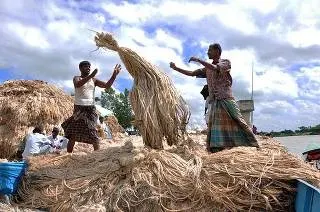Jute fiber
Jute fiber is a long, soft, shiny fiber that can be cut into thick, stiff threads to
make jute fabric. Jute fibers are mainly composed of plant materials cellulose
and lignin. It falls in the category of bust fiber along with kenaf, industrial
hemp, flax, ramie, etc. Jute fiber is also called golden fiber for its color
and high cash quality.
Properties of jute fiber
There
are two types of properties as below-
A. Physical properties of jute fiber
i.
The fiber length of jute is 1-4 miters
ii. The strength or tenacity of jute is 3-4gm/den
iii.
Elongation at break of jute is 1.7%
iv. The specific gravity of jute is 1.5
v.
Moisture Regain of jute is 13.75%
vi. The dimensional stability of jute is good
vii.
The color of jute fiber may be Brown, grey, yellow, white, off-white, golden,
etc.
B. Chemical properties of jute fiber
i.
Effects of Acid- Easily damaged by hot dilute acid and cold conc. Acid.
ii.
Effects of Alkali- Easily damaged by strong alkali.
iii.
Effects of Bleach- Resistant to all types of bleaching agents.
iv.
Effects of mildew- Prevention of mildew is better than cotton.
v.
Dyeing ability- Easy to dye. Basically, the basic dye is used for jute fiber
dyeing.
Chemical composition of jute fiber
Cellulose – 65.2%
Hemi-cellulose – 22.2%
Lignin – 10.8%
Water-soluble material – 1.5%
Fat and wax – 0.3%
Jute Harvesting and processing
About four months after planting, the harvest begins. Trees are usually cut after flowering before the flowers go to seed. The stalks are cut off close to the ground. The stalks are tied in bundles and soaked in water for about 20 days. This process softens the tissues and breaks the tight bond between the bead and the inner wood fiber stick and the process allows the fibers to separate. It is then stripped from the stalk of the long strand and washed in clean, flowing water. They are then hung or spread on the roof to dry. After 2-3 days of drying, the fibers are bound in bundles.
Uses of jute
i.
Jute is the second most important cellulose fiber after cotton
ii.
During the Industrial Revolution, jute yarn quickly replaced flax and hemp
fibers. Today, sacking still produces large quantities of manufactured jute
products,
iii.
Jute yarns and twines are also woven into curtains, chair covers, carpets, and rugs.
iv.
It is increasingly being used in rigid packaging and reinforced plastics and is
being replaced with wood in pulp and paper.
v.
Geotextiles made from jute are biodegradable, flexible, absorbs moisture, and
drain well. These are used to prevent soil erosion and landslides
vi.
Very fine threads of Hessian cloth jute can be made into imitation silk and
paper.
vii.
It is even used to produce tows, padding splints, filtering, and straining
mediums.
viii.
It is also used to make thick bags.











0 Comments